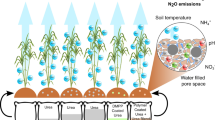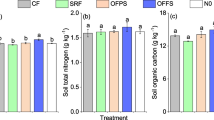Abstract
This paper reviews some of the benefits of polyolefin-coated fertilizers (POCFs) with accurate controlled release properties. They are helpful in developing innovative rice farming systems, such as no-till direct seeded rice with single basal fertilization and transplanting of rice seedlings with single basal fertilization. These new cultivation systems can increase fertilizer efficiency and reduce farming costs. The recovery of basal N can be increased from 22–23% with conventional broadcast application of ammonium sulfate or urea to 79% withco-situs application of polyolefin-coated urea. The no-till rice cultivation of transplanting of rice seedlings with single basal application of POCFs decreased the farming cost by 65% as compared to that of the conventional rice cultivation. Theco-situs application of POCFs containing NPK reduced nitrate leaching and nitrous oxide emissions from cultivated soils with heavy fertilization. Since POCFs have various nutrient composition and release types, a variety of application methods to agricultural and horticultural plants are being developed in Japan.
Similar content being viewed by others
References
Fujita T (1989) Invention and development of polyolefin-coated urea. Ph D thesis, Faculty of Agriculture, Tohoku University. Sendai, Japan
Fujita T, Takahashi C, Ohshima M, Ushioda T and Shimizu H (1977) Method of producing coated fertilizers. United States Patent 4,019,890
Fujita T, Takahashi C, Yoshida S and Shimizu H (1983) Coated granular fertilizer capable of controlling the effects of temperature upon dissolution-out rate. United States Patent 4,369,055
Fujita T, Yamashita Y, Yoshida S and Yamahira K (1989) Granular fertilizers with a degradative coating. United States Patent 4,881,963.
Gandeza AT, Shoji S and Yamada I (1991) Simulation of crop response to polyolefin-coated urea. I. Field dissolution. Soil Sci Soc Am J 55: 1462–1467
Kaneta Y, Awasaki H and Murai T (1994) The non-tillage rice culture by single application of fertilizer in a nursery box with controlled-release fertilizer. Jap J Soil Sci Plant Nutr 65: 385–391 (In Japanese)
Keeney DR (1982) Nitrogen management for maximum efficiency and minimum pollution. In: Stevenson F J (ed) Nitrogen in Agricultural Soils, pp 605–649. Agron Monogr. 22. ASA, CSSA, and SSSA, Madison, WI
Kumazawa K (1993) Environment and fertilizers: a review. Okinawa Committee for the 1993 Annual Meetings of Japanese Society of Soil Science and Plant Nutrition (In Japanese)
Kyuma K (1985) Soil temperature regimes of Japanese soils. Soil Sci Plant Nutr 31: 463–468
Minami K (1991) Emission of biogenic gas compounds from soil ecosystem and their effects on global environment: a review. Jap J Soil Sci Plant Nutr 62: 445–450 (In Japanese)
Minami K (1992) Effects of nitrification inhibitors and slow-released fertilizer on emission of nitrous oxide from soils. Res Rep Div Environ Planning (NIAES) 8: 137–146
Okumura S (1989) Effects of polyolefin-coated fertilizers on growth of tea trees. Nogyo and Kagaku 384: 1–8 (In Japanese)
Randall GW and Hoeft RG (1988) Placement methods for improved efficiency of P and K fertilizers: a review. J Prod Agric 1: 70–79
Randall GW, Wells KL and Hanway JJ (1985) Modern techniques in fertilizer application.In: Engelstad O P (ed) Fertilizer Technology and Use. 3rd ed, pp 521–560 SSSA, Madison, WI
Sahrawat KL (1989) Effects of nitrification inhibitors on nitrogen transformations, other than nitrification, in soils. Adv Agron 42: 279–309
Sato T (1993) Placement of polyolefin coated fertilizers with delayed release properties to rice seedling boxes. In application for a patent
Shoji S and Gandeza AT (1992) New concept of controlled release fertilization.In: Shoji S and Gandeza AT (ed) Controlled Release Fertilizers with Polyolefin Resin Coating, pp 1–7. Konno Printing Co. Sendai, Japan.
Shoji S, Gandeza AT and Kimura K (1991) Simulation of crop response to polyolefin-coated urea: II. Nitrogen uptake by corn. Soil Sci Soc Am J 55: 1468–1473
Kanno H, Shoji S and Ito T (1993) Response of dent corn tocositus application using controlled availability fertilizers. Bull Exp Farm, Tohoku Univ 9: 23–29 (In Japanese)
Shoji S and Mae T (1984) Dynamics of inorganic nutrients and water. In: Ecophysiology of Crops, pp 97–172. Bun-eido, Tokyo (In Japanese).
Shoji S, Muranushi E and Kimura K (1993) Rice farming by no-till direct sowing with single basal fertilization. Unpublished
Ueno M (1994) Growth and nitrogen uptake of rice plants for production of high quality rice and nitrogen application for rice plants according to natural nitrogen supply in Yamagata Prefecture. Ph D thesis submitted to Faculty of Agriculture, Tohoku University
Author information
Authors and Affiliations
Rights and permissions
About this article
Cite this article
Shoji, S., Kanno, H. Use of polyolefin-coated fertilizers for increasing fertilizer efficiency and reducing nitrate leaching and nitrous oxide emissions. Fertilizer Research 39, 147–152 (1994). https://doi.org/10.1007/BF00750913
Received:
Accepted:
Published:
Issue Date:
DOI: https://doi.org/10.1007/BF00750913




